Dolphin Conning Tower: Difference between revisions
Pbcjohnston (talk | contribs) Added picture |
Pbcjohnston (talk | contribs) mNo edit summary |
||
| (2 intermediate revisions by the same user not shown) | |||
| Line 1: | Line 1: | ||
[[File:Header 4 New.jpg]] | [[File:Header 4 New.jpg]] | ||
=== | === Conning Tower === | ||
[[File:Dolphin Con Twr-1.jpg|left|500px]] | [[File:Dolphin Con Twr-1.jpg|left|500px]] | ||
<div style="text-align: justify;"><span style="color:#00008B">The conning tower looking forward. The conning tower was a separate, horizontal watertight compartment situated above the control room. It contained one of the boat's periscope stations, a helm wheel, a navigation chart table, and torpedo firing controls. On the right is the #1 periscope. Just to the left of that at the top is the bridge access trunk. You can see daylight coming down the hatch. | <div style="text-align: justify;"><span style="color:#00008B">The conning tower looking forward. The conning tower was a separate, horizontal watertight compartment situated above the control room. It contained one of the boat's periscope stations, a helm wheel, a navigation chart table, and torpedo firing controls. On the right is the #1 periscope. Just to the left of that at the top is the bridge access trunk. You can see daylight coming down the hatch. | ||
| Line 15: | Line 15: | ||
[[File:Dolphin Con Twr-1c.jpg|left|500px]] | [[File:Dolphin Con Twr-1c.jpg|left|500px]] | ||
<div style="text-align: justify;"><span style="color:#00008B">A speaking tube, located directly above the helm wheel, probably leading to and from both the control room and the bridge. It was used by the helmsman to receive and send helm orders. You simply spoke into it and your voice carried through the pipe to the other end. Note the heavy duty closure valve to prevent flooding. This tube had to be test depth certified! | <div style="text-align: justify;"><span style="color:#00008B">A speaking tube, located directly above the helm wheel, probably leading to and from both the control room and the bridge. It was used by the helmsman to receive and send helm orders. You simply spoke into it and your voice carried through the pipe to the other end. Note the heavy duty closure valve to prevent flooding. This tube had to be test depth certified! | ||
<small>US Navy Photo Contributed by Roger Torgeson</small> | |||
[[File:Red bar sub new 2.jpg]] | |||
[[File:Dolphin Con Twr-1d.jpg|left|500px]] | |||
<div style="text-align: justify;"><span style="color:#00008B">Besides showing a close up of the starboard engine order telegraph, (showing both motor and engine selections), there is a very good close up of the external voice tube shut off valve handle. A bit of the handrail and the ladder to the bridge is seen at the right. To the left top appears to be an alarm switch, possibly the diving alarm. | |||
<small>US Navy Photo Contributed by Roger Torgeson</small> | |||
[[File:Red bar sub new 2.jpg]] | |||
[[File:Dolphin Con Twr-1e.jpg|left|500px]] | |||
<div style="text-align: justify;"><span style="color:#00008B">We are not entirely sure what this piece of equipment is. The name plate is not clear enough to be read. We are speculating that it is some sort of automatic course keeping device, similar in nature to an autopilot, but we do not know for sure. | |||
<small>US Navy Photo Contributed by Roger Torgeson</small> | |||
[[File:Red bar sub new 2.jpg]] | |||
[[File:Dolphin Con Twr-1f.jpg|left|500px]] | |||
<div style="text-align: justify;"><span style="color:#00008B">This is the conning tower flood valve referenced earlier. There is a geared reach rod shaft with a swivel union that allows it to be operated from the bridge as well. There is a battery operated battle lantern to the left and the stool for the chart table to the right. | |||
<small>US Navy Photo Contributed by Roger Torgeson</small> | |||
[[File:Red bar sub new 2.jpg]] | |||
[[File:Dolphin Con Twr-1g.jpg|left|500px]] | |||
<div style="text-align: justify;"><span style="color:#00008B">Close up of the conning tower helm area. To the left is the port engine order telegraph and the right is the rudder angle indicator showing Dolphin has an 8 degree right rudder at the time the photo was taken. | |||
The close up provides a look of the top of the mystery object sitting in the conning tower. It appears to have a polished brass cover on the top of it. Suggestions as to its purpose are welcome. | |||
In the upper right corner there looks to be a device for looking at something outside the conning tower. Most likely this is for viewing an image of the graduated ring of the magnetic compass. This is how the helmsman would know what course he was steering. The compass itself would be mounted up on the bridge. The fairing to block light appears to unbolt and the cover, above, to slide down on rails on either side and lock down over the eyepiece. There is also a petcock drain on the bottom of the device. | |||
<small>US Navy Photo Contributed by Roger Torgeson</small> | |||
[[File:Red bar sub new 2.jpg]] | |||
[[File:Dolphin Con Twr-2.jpg|left|500px]] | |||
<div style="text-align: justify;"><span style="color:#00008B">The conning tower looking aft from the helm wheel. Just to right of center is the #1 periscope used solely in the conning tower. The #2 periscope, that was used solely from the control room, was housed outside the conning tower. This arrangement was eventually done away with and both periscopes could be used in the conning tower. As an aside note it has been noted on the barrel of the periscope markings every two feet to allow the Conning Officer looking through the periscope to ask for and get the exact elevation he asks for and also remind him how much of the periscope has been raised. | |||
On the far left is a portion of the hand rail for the bridge access ladder and to the right of that are the Port and Starboard shaft RPM dials. Below them is the chart table with a desk lamp. To the right of these are the pulleys and cables for raising and lowering the #1 periscope. The motor for this can be seen at the foot of the ladder to the conning tower in the control room. | |||
The right side of the image shows at the top are the conning tower blow, vent and drain valves. Next to them are the torpedo firing buttons. This area would be rearranged later in the 1930's when a Torpedo Data Computer (TDC) would be added. | |||
To the right of the periscope is the rear deck access door. Dolphin was the first submarine to have this feature. It allowed crew to access the deck through the conning tower. Once through the door you would be in a void space inside the fairwater. There was a cutout in the side of the fairwater allowing access to the main deck. | |||
<small>US Navy Photo Contributed by Roger Torgeson</small> | |||
[[File:Red bar sub new 2.jpg]] | |||
[[File:Dolphin Con Twr-2b.jpg|left|500px]] | |||
<div style="text-align: justify;"><span style="color:#00008B">The port and starboard propeller shaft RPM meters. This gave an indication of speed, which is obviously a vital element in navigation. The Quartermasters stationed here would use this information to help plot a position on the chart. | |||
<small>US Navy Photo Contributed by Roger Torgeson</small> | |||
[[File:Red bar sub new 2.jpg]] | |||
[[File:Dolphin Con Twr-2c.jpg|left|500px]] | |||
<div style="text-align: justify;"><span style="color:#00008B">Close up of the graduated bearing ring at the top of the #1 periscope. The ring gives relative and reciprocal bearing to the target relative to the submarine. This is a key element in aiming torpedoes. Visible here is the hoist cable for the periscope. Later hoisting mechanisms were hydraulic, replacing the cable with a solid steel hydraulic ram rod. | |||
<small>US Navy Photo Contributed by Roger Torgeson</small> | |||
[[File:Red bar sub new 2.jpg]] | |||
[[File:Dolphin Con Twr-2d.jpg|left|500px]] | |||
<div style="text-align: justify;"><span style="color:#00008B">The Dolphin was the first submarine to have a water tight door in the conning tower to give access to the main deck and deck gun. Subsequent sub classes had this feature until wartime modifications removed them. Ladder steps lead up to the cigarette deck. | |||
Behind the periscope is the ships name plate with what may have been the ships motto. The first word looks to have been "FAI?" (faith?) but this is not certain. Followed by "ESS". Maybe "Faithfulness and Readiness"?, "Faithfulness and Preparedness"? If anyone finds out, please let us know. Below is the larger plate with the first and last letters of what must have been "US(blocked by periscope)N" "USS DOLPHIN" and it probably had the "SS 169" under that followed by the builder's yard and dates. | |||
<small>US Navy Photo Contributed by Roger Torgeson</small> | |||
[[File:Red bar sub new 2.jpg]] | |||
[[File:Dolphin Con Twr-2e.jpg|left|500px]] | |||
<div style="text-align: justify;"><span style="color:#00008B">At the top in this close up are the conning tower blow, vent and drain valves. | |||
To the right of the valves is the torpedo firing panel. The Dolphin had four torpedo tubes forward and two aft. These two boxes with buttons on them are firing buttons. When the order was given to fire a torpedo a command was given such as ,"Fire One", and the button was pushed. at the same time the command was broadcast to the torpedo room and a firing actuator was pushed for that tube. This was a backup in case there was a malfunction in electronic communication. | |||
Switches below the firing buttons turn the buttons on or off to prevent accidental. | |||
<small>US Navy Photo Contributed by Roger Torgeson</small> | |||
[[File:Red bar sub new 2.jpg]] | |||
[[File:Dolphin Con Twr-2f.jpg|left|500px]] | |||
<div style="text-align: justify;"><span style="color:#00008B">This is a "Butt Kit", Navy slang for ash tray. It was attached almost everywhere and was portable. They were deep to accommodate heavy usage. A peek into the top of this one shows it is almost full to the top and in need of emptying. | |||
Butt kits were mounted throughout the boat and even near bunks and at the tables in the crew's mess. In those days smoking was commonplace and accepted, and not to smoke was rare though not unheard of. | |||
<small>US Navy Photo Contributed by Roger Torgeson</small> | <small>US Navy Photo Contributed by Roger Torgeson</small> | ||
Latest revision as of 11:47, 19 June 2023
Conning Tower
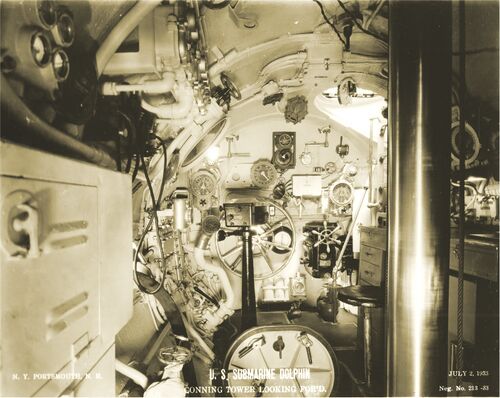
In the center bottom is the access hatch from the control room. Directly above that on the forward bulkhead is the helm.
Between the hatch and the helm there appears to be a pedestal, painted black, with a square top on it. Its function is not known for sure. It is suspected to have been placed there for temporary storage during the upkeep. It was perhaps moved from the deck or bridge. Historian Jim Christley has theorized that this could be an early version of a Sperry Mark I Target Bearing Transmitter (TBT) that was mounted on the bridge. A TBT is used to aim torpedoes while the boat is surfaced. It is used in conjunction with a pair of 7x50 binoculars.
US Navy Photo Contributed by Roger Torgeson

US Navy Photo Contributed by Roger Torgeson
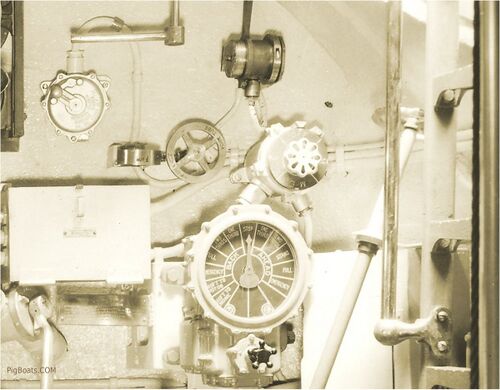
US Navy Photo Contributed by Roger Torgeson
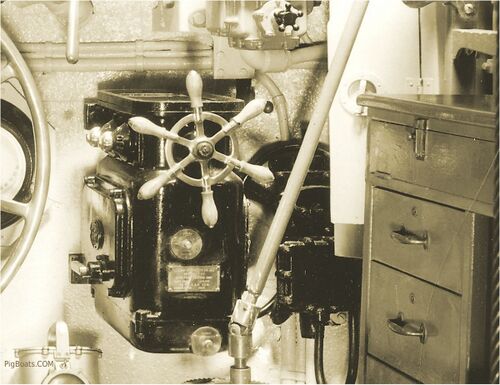
US Navy Photo Contributed by Roger Torgeson

US Navy Photo Contributed by Roger Torgeson
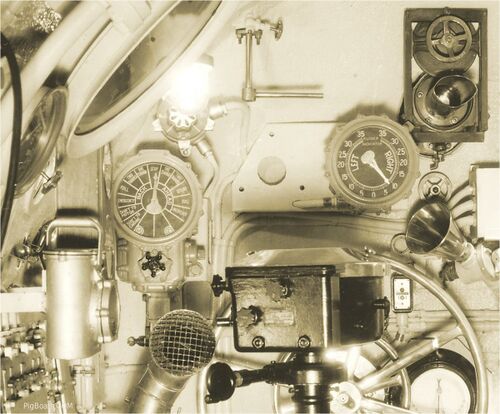
The close up provides a look of the top of the mystery object sitting in the conning tower. It appears to have a polished brass cover on the top of it. Suggestions as to its purpose are welcome.
In the upper right corner there looks to be a device for looking at something outside the conning tower. Most likely this is for viewing an image of the graduated ring of the magnetic compass. This is how the helmsman would know what course he was steering. The compass itself would be mounted up on the bridge. The fairing to block light appears to unbolt and the cover, above, to slide down on rails on either side and lock down over the eyepiece. There is also a petcock drain on the bottom of the device.
US Navy Photo Contributed by Roger Torgeson
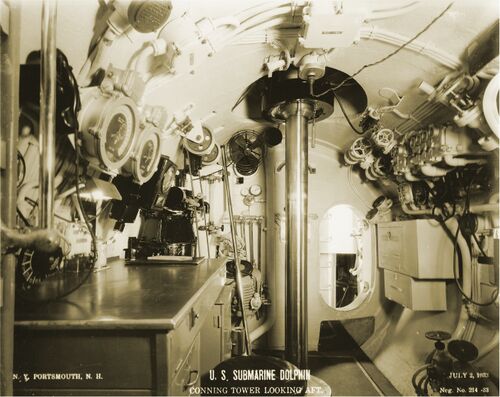
On the far left is a portion of the hand rail for the bridge access ladder and to the right of that are the Port and Starboard shaft RPM dials. Below them is the chart table with a desk lamp. To the right of these are the pulleys and cables for raising and lowering the #1 periscope. The motor for this can be seen at the foot of the ladder to the conning tower in the control room.
The right side of the image shows at the top are the conning tower blow, vent and drain valves. Next to them are the torpedo firing buttons. This area would be rearranged later in the 1930's when a Torpedo Data Computer (TDC) would be added.
To the right of the periscope is the rear deck access door. Dolphin was the first submarine to have this feature. It allowed crew to access the deck through the conning tower. Once through the door you would be in a void space inside the fairwater. There was a cutout in the side of the fairwater allowing access to the main deck.
US Navy Photo Contributed by Roger Torgeson
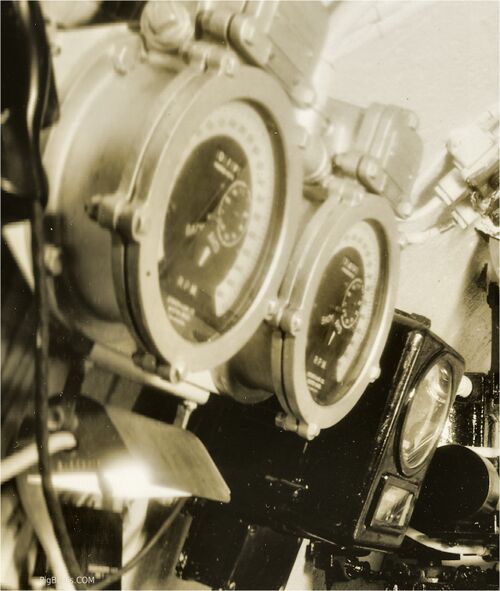
US Navy Photo Contributed by Roger Torgeson

US Navy Photo Contributed by Roger Torgeson

Behind the periscope is the ships name plate with what may have been the ships motto. The first word looks to have been "FAI?" (faith?) but this is not certain. Followed by "ESS". Maybe "Faithfulness and Readiness"?, "Faithfulness and Preparedness"? If anyone finds out, please let us know. Below is the larger plate with the first and last letters of what must have been "US(blocked by periscope)N" "USS DOLPHIN" and it probably had the "SS 169" under that followed by the builder's yard and dates.
US Navy Photo Contributed by Roger Torgeson

To the right of the valves is the torpedo firing panel. The Dolphin had four torpedo tubes forward and two aft. These two boxes with buttons on them are firing buttons. When the order was given to fire a torpedo a command was given such as ,"Fire One", and the button was pushed. at the same time the command was broadcast to the torpedo room and a firing actuator was pushed for that tube. This was a backup in case there was a malfunction in electronic communication.
Switches below the firing buttons turn the buttons on or off to prevent accidental.
US Navy Photo Contributed by Roger Torgeson

Butt kits were mounted throughout the boat and even near bunks and at the tables in the crew's mess. In those days smoking was commonplace and accepted, and not to smoke was rare though not unheard of.
US Navy Photo Contributed by Roger Torgeson
Page created by:
Ric Hedman & David Johnston
1999 - 2023 - PigBoats.COM©
Mountlake Terrace, WA, Norfolk, VA
webmaster at pigboats dot com
